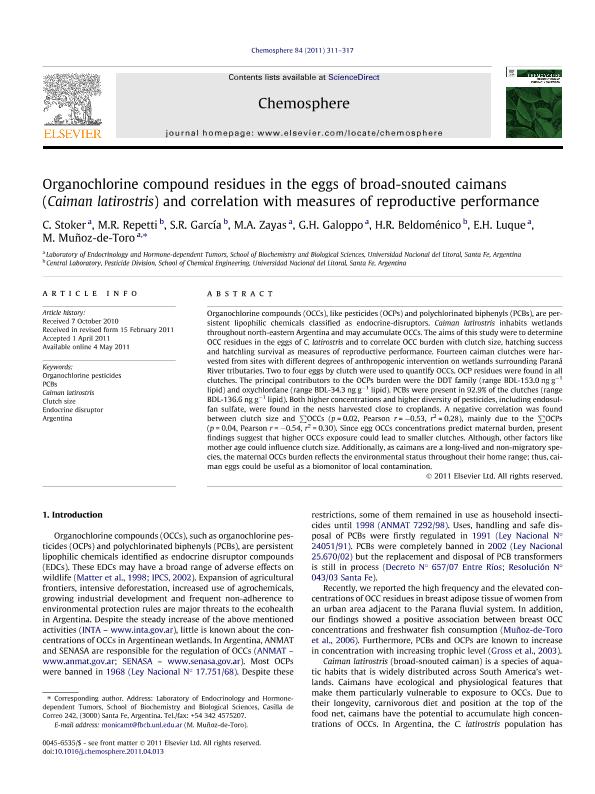Artículo
Organochlorine compound residues in the eggs of broad-snouted caimans (Caiman latirostris) and correlation with measures of reproductive performance
Stoker, Cora ; Repetti, María Rosa; García, S.R.; Zayas, Marcelo Alejandro
; Repetti, María Rosa; García, S.R.; Zayas, Marcelo Alejandro ; Galoppo, Germán Hugo; Beldoménico, H.R; Luque, Enrique Hugo
; Galoppo, Germán Hugo; Beldoménico, H.R; Luque, Enrique Hugo ; Muñoz de Toro, Monica Milagros
; Muñoz de Toro, Monica Milagros
 ; Repetti, María Rosa; García, S.R.; Zayas, Marcelo Alejandro
; Repetti, María Rosa; García, S.R.; Zayas, Marcelo Alejandro ; Galoppo, Germán Hugo; Beldoménico, H.R; Luque, Enrique Hugo
; Galoppo, Germán Hugo; Beldoménico, H.R; Luque, Enrique Hugo ; Muñoz de Toro, Monica Milagros
; Muñoz de Toro, Monica Milagros
Fecha de publicación:
06/2011
Editorial:
Pergamon-Elsevier Science Ltd
Revista:
Chemosphere
ISSN:
0045-6535
Idioma:
Inglés
Tipo de recurso:
Artículo publicado
Clasificación temática:
Resumen
Organochlorine compounds (OCCs), like pesticides (OCPs) and polychlorinated biphenyls (PCBs), are persistent lipophilic chemicals classified as endocrine-disruptors. Caiman latirostris inhabits wetlands throughout north-eastern Argentina and may accumulate OCCs. The aims of this study were to determine OCC residues in the eggs of C. latirostris and to correlate OCC burden with clutch size, hatching success and hatchling survival as measures of reproductive performance. Fourteen caiman clutches were harvested from sites with different degrees of anthropogenic intervention on wetlands surrounding Paraná River tributaries. Two to four eggs by clutch were used to quantify OCCs. OCP residues were found in all clutches. The principal contributors to the OCPs burden were the DDT family (range BDL-153.0ngg-1 lipid) and oxychlordane (range BDL-34.3ngg-1 lipid). PCBs were present in 92.9% of the clutches (range BDL-136.6ngg-1 lipid). Both higher concentrations and higher diversity of pesticides, including endosulfan sulfate, were found in the nests harvested close to croplands. A negative correlation was found between clutch size and ∑OCCs (p=0.02, Pearson r=-0.53, r2=0.28), mainly due to the ∑OCPs (p=0.04, Pearson r=-0.54, r2=0.30). Since egg OCCs concentrations predict maternal burden, present findings suggest that higher OCCs exposure could lead to smaller clutches. Although, other factors like mother age could influence clutch size. Additionally, as caimans are a long-lived and non-migratory species, the maternal OCCs burden reflects the environmental status throughout their home range; thus, caiman eggs could be useful as a biomonitor of local contamination.
Archivos asociados
Licencia
Identificadores
Colecciones
Articulos(CCT - SANTA FE)
Articulos de CTRO.CIENTIFICO TECNOL.CONICET - SANTA FE
Articulos de CTRO.CIENTIFICO TECNOL.CONICET - SANTA FE
Citación
Stoker, Cora; Repetti, María Rosa; García, S.R.; Zayas, Marcelo Alejandro; Galoppo, Germán Hugo; et al.; Organochlorine compound residues in the eggs of broad-snouted caimans (Caiman latirostris) and correlation with measures of reproductive performance; Pergamon-Elsevier Science Ltd; Chemosphere; 84; 3; 6-2011; 311-317
Compartir
Altmétricas



